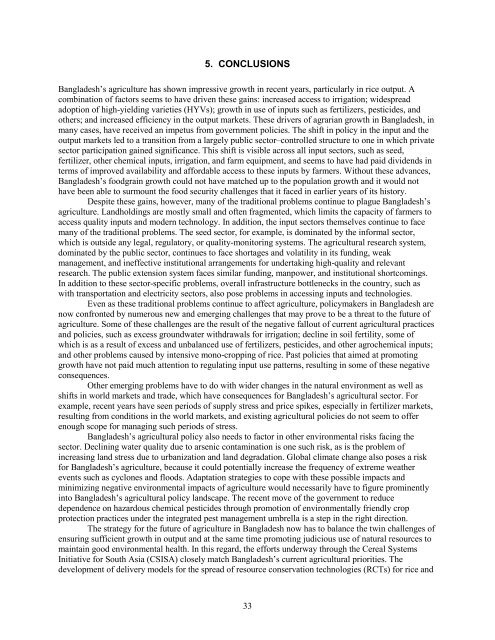Review of Input and Output Policies for Cereal Production in ...
Review of Input and Output Policies for Cereal Production in ...
Review of Input and Output Policies for Cereal Production in ...
You also want an ePaper? Increase the reach of your titles
YUMPU automatically turns print PDFs into web optimized ePapers that Google loves.
5. CONCLUSIONS<br />
Bangladesh’s agriculture has shown impressive growth <strong>in</strong> recent years, particularly <strong>in</strong> rice output. A<br />
comb<strong>in</strong>ation <strong>of</strong> factors seems to have driven these ga<strong>in</strong>s: <strong>in</strong>creased access to irrigation; widespread<br />
adoption <strong>of</strong> high-yield<strong>in</strong>g varieties (HYVs); growth <strong>in</strong> use <strong>of</strong> <strong>in</strong>puts such as fertilizers, pesticides, <strong>and</strong><br />
others; <strong>and</strong> <strong>in</strong>creased efficiency <strong>in</strong> the output markets. These drivers <strong>of</strong> agrarian growth <strong>in</strong> Bangladesh, <strong>in</strong><br />
many cases, have received an impetus from government policies. The shift <strong>in</strong> policy <strong>in</strong> the <strong>in</strong>put <strong>and</strong> the<br />
output markets led to a transition from a largely public sector–controlled structure to one <strong>in</strong> which private<br />
sector participation ga<strong>in</strong>ed significance. This shift is visible across all <strong>in</strong>put sectors, such as seed,<br />
fertilizer, other chemical <strong>in</strong>puts, irrigation, <strong>and</strong> farm equipment, <strong>and</strong> seems to have had paid dividends <strong>in</strong><br />
terms <strong>of</strong> improved availability <strong>and</strong> af<strong>for</strong>dable access to these <strong>in</strong>puts by farmers. Without these advances,<br />
Bangladesh’s foodgra<strong>in</strong> growth could not have matched up to the population growth <strong>and</strong> it would not<br />
have been able to surmount the food security challenges that it faced <strong>in</strong> earlier years <strong>of</strong> its history.<br />
Despite these ga<strong>in</strong>s, however, many <strong>of</strong> the traditional problems cont<strong>in</strong>ue to plague Bangladesh’s<br />
agriculture. L<strong>and</strong>hold<strong>in</strong>gs are mostly small <strong>and</strong> <strong>of</strong>ten fragmented, which limits the capacity <strong>of</strong> farmers to<br />
access quality <strong>in</strong>puts <strong>and</strong> modern technology. In addition, the <strong>in</strong>put sectors themselves cont<strong>in</strong>ue to face<br />
many <strong>of</strong> the traditional problems. The seed sector, <strong>for</strong> example, is dom<strong>in</strong>ated by the <strong>in</strong><strong>for</strong>mal sector,<br />
which is outside any legal, regulatory, or quality-monitor<strong>in</strong>g systems. The agricultural research system,<br />
dom<strong>in</strong>ated by the public sector, cont<strong>in</strong>ues to face shortages <strong>and</strong> volatility <strong>in</strong> its fund<strong>in</strong>g, weak<br />
management, <strong>and</strong> <strong>in</strong>effective <strong>in</strong>stitutional arrangements <strong>for</strong> undertak<strong>in</strong>g high-quality <strong>and</strong> relevant<br />
research. The public extension system faces similar fund<strong>in</strong>g, manpower, <strong>and</strong> <strong>in</strong>stitutional shortcom<strong>in</strong>gs.<br />
In addition to these sector-specific problems, overall <strong>in</strong>frastructure bottlenecks <strong>in</strong> the country, such as<br />
with transportation <strong>and</strong> electricity sectors, also pose problems <strong>in</strong> access<strong>in</strong>g <strong>in</strong>puts <strong>and</strong> technologies.<br />
Even as these traditional problems cont<strong>in</strong>ue to affect agriculture, policymakers <strong>in</strong> Bangladesh are<br />
now confronted by numerous new <strong>and</strong> emerg<strong>in</strong>g challenges that may prove to be a threat to the future <strong>of</strong><br />
agriculture. Some <strong>of</strong> these challenges are the result <strong>of</strong> the negative fallout <strong>of</strong> current agricultural practices<br />
<strong>and</strong> policies, such as excess groundwater withdrawals <strong>for</strong> irrigation; decl<strong>in</strong>e <strong>in</strong> soil fertility, some <strong>of</strong><br />
which is as a result <strong>of</strong> excess <strong>and</strong> unbalanced use <strong>of</strong> fertilizers, pesticides, <strong>and</strong> other agrochemical <strong>in</strong>puts;<br />
<strong>and</strong> other problems caused by <strong>in</strong>tensive mono-cropp<strong>in</strong>g <strong>of</strong> rice. Past policies that aimed at promot<strong>in</strong>g<br />
growth have not paid much attention to regulat<strong>in</strong>g <strong>in</strong>put use patterns, result<strong>in</strong>g <strong>in</strong> some <strong>of</strong> these negative<br />
consequences.<br />
Other emerg<strong>in</strong>g problems have to do with wider changes <strong>in</strong> the natural environment as well as<br />
shifts <strong>in</strong> world markets <strong>and</strong> trade, which have consequences <strong>for</strong> Bangladesh’s agricultural sector. For<br />
example, recent years have seen periods <strong>of</strong> supply stress <strong>and</strong> price spikes, especially <strong>in</strong> fertilizer markets,<br />
result<strong>in</strong>g from conditions <strong>in</strong> the world markets, <strong>and</strong> exist<strong>in</strong>g agricultural policies do not seem to <strong>of</strong>fer<br />
enough scope <strong>for</strong> manag<strong>in</strong>g such periods <strong>of</strong> stress.<br />
Bangladesh’s agricultural policy also needs to factor <strong>in</strong> other environmental risks fac<strong>in</strong>g the<br />
sector. Decl<strong>in</strong><strong>in</strong>g water quality due to arsenic contam<strong>in</strong>ation is one such risk, as is the problem <strong>of</strong><br />
<strong>in</strong>creas<strong>in</strong>g l<strong>and</strong> stress due to urbanization <strong>and</strong> l<strong>and</strong> degradation. Global climate change also poses a risk<br />
<strong>for</strong> Bangladesh’s agriculture, because it could potentially <strong>in</strong>crease the frequency <strong>of</strong> extreme weather<br />
events such as cyclones <strong>and</strong> floods. Adaptation strategies to cope with these possible impacts <strong>and</strong><br />
m<strong>in</strong>imiz<strong>in</strong>g negative environmental impacts <strong>of</strong> agriculture would necessarily have to figure prom<strong>in</strong>ently<br />
<strong>in</strong>to Bangladesh’s agricultural policy l<strong>and</strong>scape. The recent move <strong>of</strong> the government to reduce<br />
dependence on hazardous chemical pesticides through promotion <strong>of</strong> environmentally friendly crop<br />
protection practices under the <strong>in</strong>tegrated pest management umbrella is a step <strong>in</strong> the right direction.<br />
The strategy <strong>for</strong> the future <strong>of</strong> agriculture <strong>in</strong> Bangladesh now has to balance the tw<strong>in</strong> challenges <strong>of</strong><br />
ensur<strong>in</strong>g sufficient growth <strong>in</strong> output <strong>and</strong> at the same time promot<strong>in</strong>g judicious use <strong>of</strong> natural resources to<br />
ma<strong>in</strong>ta<strong>in</strong> good environmental health. In this regard, the ef<strong>for</strong>ts underway through the <strong>Cereal</strong> Systems<br />
Initiative <strong>for</strong> South Asia (CSISA) closely match Bangladesh’s current agricultural priorities. The<br />
development <strong>of</strong> delivery models <strong>for</strong> the spread <strong>of</strong> resource conservation technologies (RCTs) <strong>for</strong> rice <strong>and</strong><br />
33
















